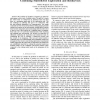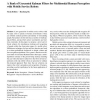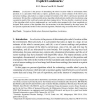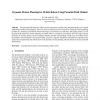CRV
2011
IEEE
12 years 4 months ago
2011
IEEE
—We consider the problem of exploring an unknown environment with a pair of mobile robots. The goal is to make the robots meet (or rendezvous) in minimum time such that there is ...
AAAI
2011
12 years 4 months ago
2011
When mobile robots perform tasks in environments with humans, it seems appropriate for the robots to rely on such humans for help instead of dedicated human oracles or supervisors...
IJSR
2010
13 years 1 months ago
2010
A new generation of mobile service robots could be ready soon to operate in human environments if they can robustly estimate position and identity of surrounding people. Researcher...
RAS
2008
13 years 4 months ago
2008
We present an approach for creating conceptual representations of human-made indoor environments using mobile robots. The concepts refer to spatial and functional properties of ty...
TROB
2002
13 years 4 months ago
2002
Abstract--With the services that autonomous robots are to provide becoming more demanding, the states that the robots have to estimate become more complex. In this article, we deve...
NN
1998
Springer
13 years 4 months ago
1998
Springer
In this article we describe a methodology for evolving neurocontrollers of autonomous mobile robots without human intervention. The presentation, which spans from technological an...
ML
1998
ACM
13 years 4 months ago
1998
ACM
To operate successfully in indoor environments, mobile robots must be able to localize themselves. Most current localization algorithms lack flexibility, autonomy, and often optim...
ALGORITHMICA
2000
13 years 4 months ago
2000
Localization is the process of determining the robot's location within its environment. More precisely, it is a procedure which takes as input a geometric map, a current estim...
AROBOTS
2002
13 years 4 months ago
2002
The potential field method is widely used for autonomous mobile robot path planning due to its elegant mathematical analysis and simplicity. However, most researches have been focu...
JNW
2007
13 years 4 months ago
2007
— This paper presents a fail-safe platform on which cooperative mobile robots rely for their motion. The platform consists of a collision prevention protocol for a dynamic group ...




